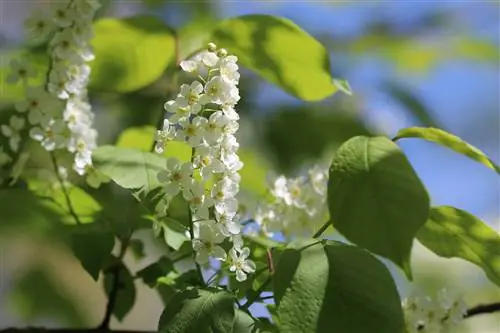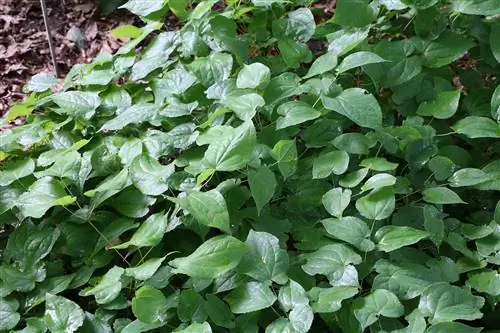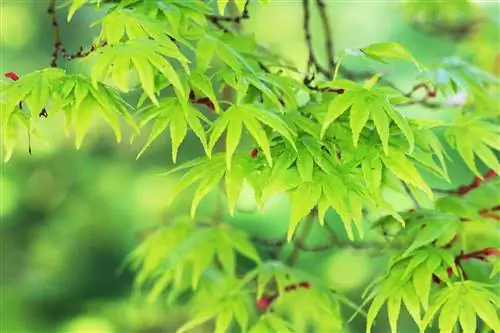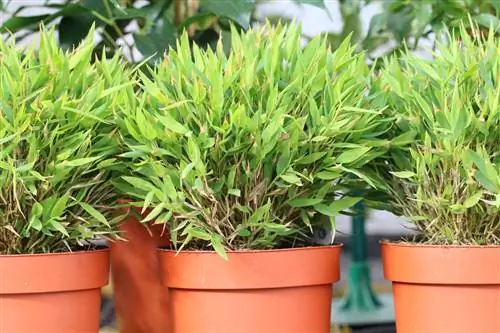- Author admin [email protected].
- Public 2023-12-17 03:39.
- Last modified 2025-01-24 12:45.
The record sheet lives up to its name. It is primarily the magnificent leaves, which are reminiscent of horse chestnuts in shape, that catch your eye. The plant also scores with lush, cream-colored flowers. And because it is extremely undemanding and easy to care for, it is an asset to any garden - especially if it has a pond.
Floor
What generally applies to Rodgersia, the botanical name of the leaf, also applies to the demands it has on the soil - they are extremely modest. The plant thrives just as well in sandy soil as it does in soil with a high clay content. You should only make sure that no permanent waterlogging can form. The record sheet doesn't cope particularly well with that. In some circumstances, it may be advisable to install a drainage system in order to counter the risk of the roots of Rodgersia being permanently submerged in water as effectively as possible. If you are particularly keen on the record sheet, it is best to ensure that the soil has a high proportion of humus, even if it is not absolutely necessary.
Fertilize
Rodgersia is very frugal in every respect. This also applies to the plant's nutrient requirements. Regular fertilization is therefore not necessary. It is completely sufficient if you add a commercially available complete fertilizer to the leaflet in spring and summer. In addition, the fallen leaves should be left lying around and collected in the root area. It not only serves as protection from the cold in winter, but also provides nutrients - namely when it has broken down into humus. The humus is carefully worked into the surrounding soil with a rake.
Planting
The display leaf is usually purchased as a young plant from a gardener or in a gardening store. It therefore only needs to be planted at the chosen location in the garden. The perfect time for this is the beginning of spring. This is how you go about planting
before:
- Water the root ball thoroughly in a bucket of water
- Dig the planting hole (twice the size of the root ball)
- Loosen the bottom of the planting hole well with a rake
- possibly create a drainage system made of gravel or pottery shards
- Carefully pull the root ball apart a little
- then place it in the middle of the planting hole and fill the spaces with soil
- Press the soil well and water thoroughly immediately
Tip:
To make watering easier later, it is recommended to create a watering edge when planting. Important: The watering edge must slope towards the center of the plant.
Pouring
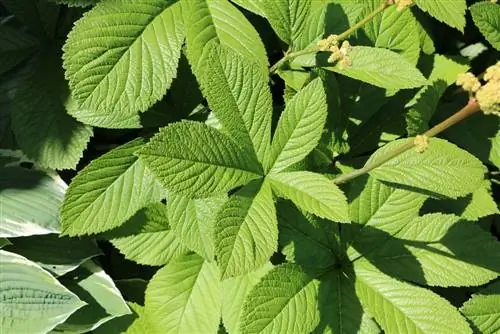
The record sheet likes it moist. Depending on the location you choose, you can't avoid watering it regularly in summer. However, you should proceed with caution. The soil in the area of the roots should be moist, but not soaking wet. It can also be allowed to dry a little in between. It is important to avoid waterlogging at all costs. Ideally, you should water directly in the root area and not from above over the leaves. The latter can cause burns to the leaves when exposed to sunlight. The reason for this is the water droplets on the leaves, which can act like a magnifying glass.
Diseases and pests
As already mentioned: Rodgersia is really tough. This also means that the plant is surprisingly resistant to diseases and pests. Problems usually only arise when several display leaves are planted too close together or there is not enough distance from other plants. As a result, air circulation usually suffers, which in turn promotes the formation of gray mold. This can be recognized by a velvety gray coating on the leaves. These must then be completely cut off in order to contain further spread. The leaves are then immediately disposed of in the garbage can and must under no circumstances be left near the affected plant.
Cutting
A regular cut or an annual pruning is not necessary. The record sheet will develop splendidly even without these measures. If necessary, you can cut off the faded stems from the previous year in spring and thin out the plant a little in this way. Drastic pruning is only an option if the leaf is growing too profusely. Then the entire bush is shortened down to the ground. The ideal time for this measure is late autumn. However, you should be aware that Rodgersia will only grow more profusely after a relatively short period of time.
Varieties
Not all record sheets are the same, of course. We now also have various varieties available. Which one you choose as a garden owner is of course a matter of taste. The following varieties are very popular:
- Chestnut-leaved display leaf, is perfect for planting on the banks of a pond
- Display sheet “The Beautiful”, blooms soft pink and also tolerates sunny locations
- Display sheet “Chocolate Wings”, scores with chocolate-colored leaf shoots and a lush play of colors in autumn
- Pediolate leaf “Smaragd”, forms emerald green leaves
- Elder-leaved leaf “Rothaut”, enchants with dark red leaves, light pink flowers and red stems
- “Bloody Mary” leaflet, shines with dark red leaves and red flowers
All of these varieties get along well with other plants. However, when combining, you should always make sure that enough distance is maintained. The minimum distance should be 100 cm. By the way, the “Bloody Mary” leaflet copes well with the pronounced roots of larger trees.
Location
Yes, the record sheet likes it warm in summer, but not sunny. The ideal location for the plant is therefore in partial shade. It is also important that there is a certain level of protection from gusts of wind. When choosing a location, you should also keep in mind that Rodgersia can take on very sprawling shapes. So you need enough space so that the plant's impressive foliage can fully develop in all its glory. Basically, the record sheet should be understood as a solitaire. If it is to be planted in groups, it is important to ensure that a minimum distance of 90 cm is maintained.
Tip:
Rodgersia is perfect for beautifying the bank of a garden pond, even if it is of course not an aquatic plant. There it has the opportunity to develop sufficiently towards the pond and is just as protected as in the shade of larger trees.
The location should be chosen carefully. The record sheet can no longer be dug up and moved later. It must therefore inevitably remain at the location once chosen. It is therefore advisable to consider whether the plant can stay there permanently and not be a nuisance. The immediate vicinity of a garden path, for example, should of course be avoided.
Wintering
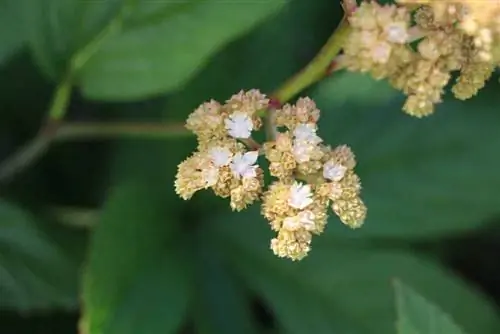
Overwintering is simply not necessary. Rodgersia is extremely tough and copes wonderfully with ice and snow. No wonder: the plant originally comes from the Himalayas, so it is very familiar with icy conditions. Even if the leaf is hardy, it can't hurt to add a layer of leaves or mulch to the root area in the fall. Then you are definitely on the safe side, even if the freezing temperatures last for a particularly long time.
Propagation
In order to propagate the display leaf, its rhizome must be divided. However, you should keep in mind that Rodgersia grows relatively slowly. In the first two years after planting, dividing the rhizome is therefore not advisable. However, from the third year onwards, division and vegetative propagation are possible. It can be done in spring or autumn.
Usage
Rodgersia is a purely ornamental plant. Its sole purpose is to beautify a garden. This happens primarily through their impressive foliage, which can have different colors depending on the variety you choose. The flowers can also be cut off and placed in a vase as cut flowers. However, the flower itself will not survive there for very long. Normally the flowers stop blooming after three to five days.
Tip:
As a lushly growing plant, the display leaf is particularly suitable when it comes to closing unsightly gaps in the garden. However, the gap should also be large enough for this (two meters minimum).


